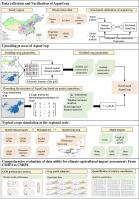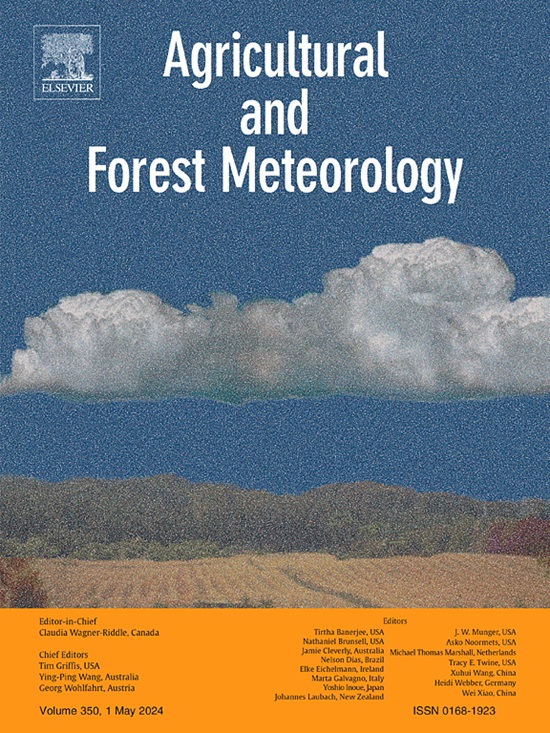Evaluating the phase evolution of CMIP GCMs for agricultural climate-change impact assessments in China
IF 5.6
1区 农林科学
Q1 AGRONOMY
引用次数: 0
Abstract
The performance of general circulation models (GCMs) in the Coupled Model Intercomparison Project (CMIP) critically determines the reliability of climate-change impact assessments and has continuously progressed (e.g., from CMIP3, CMIP5 to CMIP6). It remains unclear whether this progression enhances the reliability in evaluating the effects of climate change on agricultural systems at a daily resolution, particularly concerning crop production. To address this question, the study selected AquaCrop as a crop model for large-scale agricultural impact assessment due to its compatibility, robustness, and simplicity. Subsequently, the study coupled AquaCrop with multiple GCMs from different CMIP phases: 9 from CMIP3, 14 from CMIP5, and 15 from CMIP6, and attributed GCM-driven crop yield simulations to GCM biases over China. According to the modeling results, the progression enhanced the simulation performance for daily precipitation and temperature. The impacts of CMIPs on assessment results exhibited variability across temporal scales and crop types, further modulated by water management practices. Overall, crop simulations across three CMIP phases revealed a reduction in cold and water stresses, a shortened growing period (particularly evident in CMIP6), and an underestimation of yields. The evolution of CMIP phases increased spatial-temporal correlations for maize (0.61 to 0.81), wheat (0.68 to 0.77), and rice (0.63 to 0.77), without significantly reducing yield biases. Yield biases in early growth period were primarily influenced by daily temperature fluctuations, while biases in latter growth period were correlated with precipitation and maximum temperature. Irrigation mitigated the crop model's sensitivity to precise daily precipitation data compared to rainfed systems. This comprehensive analysis suggests, when evaluating climate change impacts on agriculture—at least for Chinese crops—CMIP6 better captured regional and temporal yield distributions than earlier phases, despite potentially underestimating yields and growth periods in certain regions.


为中国农业气候变化影响评估评估 CMIP GCMs 的阶段演化
耦合模式相互比较项目(CMIP)中的大气环流模式(GCM)的性能对气候变化影响评估的可靠性起着至关重要的决定作用,并且一直在不断进步(例如,从 CMIP3、CMIP5 到 CMIP6)。目前仍不清楚这一进展是否提高了以日分辨率评估气候变化对农业系统影响的可靠性,特别是在作物生产方面。为了解决这个问题,研究选择了 AquaCrop 作为大规模农业影响评估的作物模型,因为 AquaCrop 具有兼容性、稳健性和简易性。随后,研究将 AquaCrop 与 CMIP 不同阶段的多个 GCMs 相耦合:9 个来自 CMIP3,14 个来自 CMIP5,15 个来自 CMIP6,并将 GCM 驱动的作物产量模拟归因于中国上空的 GCM 偏差。根据建模结果,CMIPs 的进展提高了日降水量和温度的模拟性能。CMIPs 对评估结果的影响在不同时间尺度和作物类型上表现出差异性,并受到水资源管理实践的进一步影响。总体而言,CMIP 三个阶段的作物模拟结果表明,冷胁迫和水胁迫减少,生长期缩短(在 CMIP6 中尤为明显),产量被低估。CMIP 阶段的演变增加了玉米(从 0.61 到 0.81)、小麦(从 0.68 到 0.77)和水稻(从 0.63 到 0.77)的时空相关性,但并未显著减少产量偏差。生长前期的产量偏差主要受日气温波动的影响,而生长后期的偏差则与降水和最高气温相关。与雨水灌溉系统相比,灌溉减轻了作物模型对精确的日降水量数据的敏感性。这项综合分析表明,在评估气候变化对农业的影响时--至少对中国作物而言--MMIP6 比早期阶段更好地捕捉了区域和时间产量分布,尽管可能低估了某些地区的产量和生长期。
本文章由计算机程序翻译,如有差异,请以英文原文为准。
求助全文
约1分钟内获得全文
求助全文
来源期刊
CiteScore
10.30
自引率
9.70%
发文量
415
审稿时长
69 days
期刊介绍:
Agricultural and Forest Meteorology is an international journal for the publication of original articles and reviews on the inter-relationship between meteorology, agriculture, forestry, and natural ecosystems. Emphasis is on basic and applied scientific research relevant to practical problems in the field of plant and soil sciences, ecology and biogeochemistry as affected by weather as well as climate variability and change. Theoretical models should be tested against experimental data. Articles must appeal to an international audience. Special issues devoted to single topics are also published.
Typical topics include canopy micrometeorology (e.g. canopy radiation transfer, turbulence near the ground, evapotranspiration, energy balance, fluxes of trace gases), micrometeorological instrumentation (e.g., sensors for trace gases, flux measurement instruments, radiation measurement techniques), aerobiology (e.g. the dispersion of pollen, spores, insects and pesticides), biometeorology (e.g. the effect of weather and climate on plant distribution, crop yield, water-use efficiency, and plant phenology), forest-fire/weather interactions, and feedbacks from vegetation to weather and the climate system.

 求助内容:
求助内容: 应助结果提醒方式:
应助结果提醒方式:


